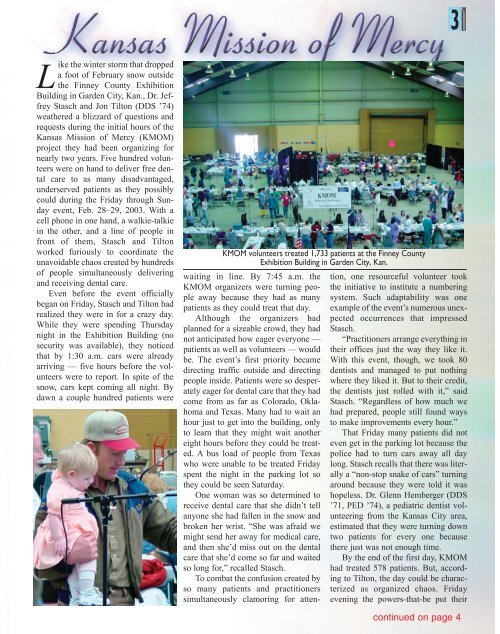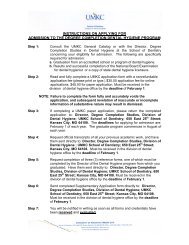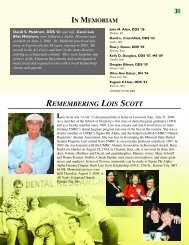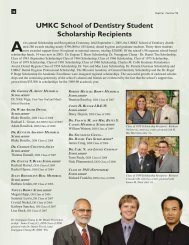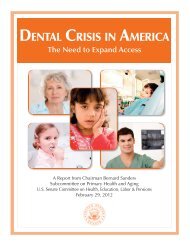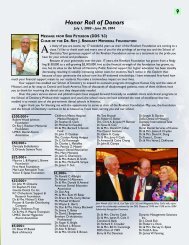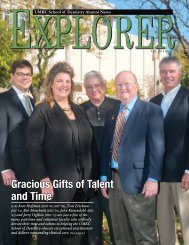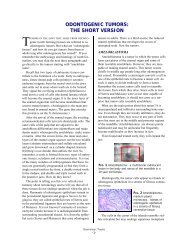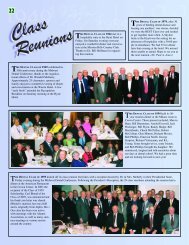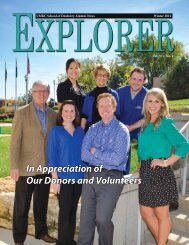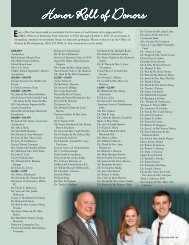explorer 03.qxd - UMKC School of Dentistry
explorer 03.qxd - UMKC School of Dentistry
explorer 03.qxd - UMKC School of Dentistry
- No tags were found...
Create successful ePaper yourself
Turn your PDF publications into a flip-book with our unique Google optimized e-Paper software.
3Like the winter storm that droppeda foot <strong>of</strong> February snow outsidethe Finney County ExhibitionBuilding in Garden City, Kan., Dr. JeffreyStasch and Jon Tilton (DDS ’74)weathered a blizzard <strong>of</strong> questions andrequests during the initial hours <strong>of</strong> theKansas Mission <strong>of</strong> Mercy (KMOM)project they had been organizing fornearly two years. Five hundred volunteerswere on hand to deliver free dentalcare to as many disadvantaged,underserved patients as they possiblycould during the Friday through Sundayevent, Feb. 28–29, 2003. With acell phone in one hand, a walkie-talkiein the other, and a line <strong>of</strong> people infront <strong>of</strong> them, Stasch and Tiltonworked furiously to coordinate theunavoidable chaos created by hundreds<strong>of</strong> people simultaneously deliveringand receiving dental care.Even before the event <strong>of</strong>ficiallybegan on Friday, Stasch and Tilton hadrealized they were in for a crazy day.While they were spending Thursdaynight in the Exhibition Building (nosecurity was available), they noticedthat by 1:30 a.m. cars were alreadyarriving — five hours before the volunteerswere to report. In spite <strong>of</strong> thesnow, cars kept coming all night. Bydawn a couple hundred patients wereKMOM volunteers treated 1,733 patients at the Finney CountyExhibition Building in Garden City, Kan.waiting in line. By 7:45 a.m. theKMOM organizers were turning peopleaway because they had as manypatients as they could treat that day.Although the organizers hadplanned for a sizeable crowd, they hadnot anticipated how eager everyone —patients as well as volunteers — wouldbe. The event’s first priority becamedirecting traffic outside and directingpeople inside. Patients were so desperatelyeager for dental care that they hadcome from as far as Colorado, Oklahomaand Texas. Many had to wait anhour just to get into the building, onlyto learn that they might wait anothereight hours before they could be treated.A bus load <strong>of</strong> people from Texaswho were unable to be treated Fridayspent the night in the parking lot sothey could be seen Saturday.One woman was so determined toreceive dental care that she didn’t tellanyone she had fallen in the snow andbroken her wrist. “She was afraid wemight send her away for medical care,and then she’d miss out on the dentalcare that she’d come so far and waitedso long for,” recalled Stasch.To combat the confusion created byso many patients and practitionerssimultaneously clamoring for attention,one resourceful volunteer tookthe initiative to institute a numberingsystem. Such adaptability was oneexample <strong>of</strong> the event’s numerous unexpectedoccurrences that impressedStasch.“Practitioners arrange everything intheir <strong>of</strong>fices just the way they like it.With this event, though, we took 80dentists and managed to put nothingwhere they liked it. But to their credit,the dentists just rolled with it,” saidStasch. “Regardless <strong>of</strong> how much wehad prepared, people still found waysto make improvements every hour.”That Friday many patients did noteven get in the parking lot because thepolice had to turn cars away all daylong. Stasch recalls that there was literallya “non-stop snake <strong>of</strong> cars” turningaround because they were told it washopeless. Dr. Glenn Hemberger (DDS’71, PED ’74), a pediatric dentist volunteeringfrom the Kansas City area,estimated that they were turning downtwo patients for every one becausethere just was not enough time.By the end <strong>of</strong> the first day, KMOMhad treated 578 patients. But, accordingto Tilton, the day could be characterizedas organized chaos. Fridayevening the powers-that-be put theircontinued on page 4
4A few <strong>of</strong> the more than 500 KMOM volunteers.heads together to figure out how toimprove for Saturday“Friday we looked like a deer inheadlights. Saturday morning welooked like an eagle looking for itsbreakfast,” said Tilton.By noon Saturday, KMOM hadtreated as many patients as it had allday Friday. To increase efficiency andspeed, an “assembly line <strong>of</strong> procedurerows” had been established: one fornumbing, another for extractions, andothers for fillings and pediatrics. Dr.Hemberger, as a pediatric dentist,worked non-stop Saturday because heknew there were more kids than couldbe seen. People were beginning to getfatigued by noon, and he worried thatthey might run out <strong>of</strong> gas in the afternoon.But after lunch the place wasmoving so well that dentists were puttingchairs next to chairs so they couldline patients up and have the next oneready to go.By the end <strong>of</strong> the two and half dayevent, 82 dentists, 61 dental hygienists,135 auxiliaries, dozens <strong>of</strong> translatorsand 257 non-dental personnel haddelivered dental treatment to 1,733patients. KMOM organizers estimatethat more than $510,000 worth <strong>of</strong> freedental care was provided.ON AMISSION FOR THE MISSIONDr. Tilton first learned about Mission<strong>of</strong> Mercy projects in 2001 whileattending, on behalf <strong>of</strong> the KansasDental Association, the ADA’s PresidentElect Conference in Chicago. Thestate <strong>of</strong> Virginia made a presentationabout their MOM project. Tilton heardabout MOM projects again at theADA’s Presidents Conference whenorganizers <strong>of</strong> a Texas MOM made apresentation. By 2002 Tilton had heardenough. He contacted the ADA to findout who could help set up a MOMproject in Kansas. Tilton then turned toEDr. Terry Dickinson, founder <strong>of</strong> theoriginal Virginia MOM and, at thattime, executive director <strong>of</strong> the VirginiaDental Association. Tilton alsoreceived guidance from Dr. DavidNicols in Texas.Dickinson told Tilton that “heneeded to live it to believe it” andinvited him to participate in a MOMproject in Wise, Vir. In July 2002 Drs.Tilton and Stasch went to Wise toexperience a MOM project for themselves.Upon their return to Kansasthey began promoting their plans forKMOM to dental societies, healthorganizations and newspapers.To determine the location for theKMOM project, Stasch and Tiltonconsulted Kim Moore, president <strong>of</strong>United Methodist Health MinistriesFund in Kansas. Moore possessed firsthandknowledge about areas <strong>of</strong> need inKansas because <strong>of</strong> his work with theMinistries. At the top <strong>of</strong> Moore’s list <strong>of</strong>areas in need <strong>of</strong> dental care was GardenCity, which coincidentally washome to Dr. Stasch and his dental practice,which became the command andcontrol center for the event. AlthoughGarden City lacked an airplane hangerlike the one that housed the VirginiaMOM, it did have the Finney Countycontinued on next pageKMOM’S C OMING TO THEveryone’s invited to take part in theKansas City Mission <strong>of</strong> Mercy project, Friday through Sunday,August 22–24, at the Kansas Speedway in Kansas City, Kan. Eventorganizers include Lisa Gonzalez (DDS ’87), Dr. Michelle Regas andGlenn Hemberger (DDS ’71, PED ’74). For more information and toregister for the event, visit KDA’s website at www.ksdental.org, orcall 1-800-432-3583.
Exhibition Building, two neighboring 4-H buildings and agrandstand that would work just fine for KMOM. Selectingthe dates, Feb. 28 through March 2, was easy — that waswhen the facility would be available.Kevin Robertson, director <strong>of</strong> KDA, prepared a Powerpointpresentation (loaded with pictures from the Virginiaproject) for Stasch and Tilton to use as they “begged, borrowedand cajoled” the 11 KDA districts for support withvolunteers, supplies or money. Tilton proudly recalls “thatevery district donated money, and some donations camestraight from dentists’ pockets.” They also received a grantfrom the United Methodist Health Ministries in Hutchison,Kan. By January 2003, KMOM had raised $75,000.Stasch and Tilton continued to promote the event toorganizations and the media. They contacted school nurses,allied health groups, Lions Clubs, Head Start, Rotary Clubs,Kiwanis, churches, area business people and any group thatprinted any kind <strong>of</strong> event calendar. “If anyone could get fourpeople together in a room I’d go talk to them,” Stasch said.The local newspaper, Garden City Telegram, reported ontheir progress regularly. A Spanish languageradio station and newspaperpicked up the story, as did area televisionstations. As momentum and attentiongrew, Stasch <strong>of</strong>fice at times found itselfhosting and providing interviews to twonews crews at the same time.5MAKING THE MOST OF KMOMFirst and foremost Stasch and Tiltonhad intended KMOM to deliver muchneededdental care to people who, forwhatever reason, were not likely to getit any other way. Secondarily, though,KMOM was intended to raise public(and political) awareness <strong>of</strong> accessissues in dentistry. After Kathleen Sebeliuswas elected governor <strong>of</strong> Kansas,Roberson and the KDA <strong>of</strong>ficers traveledto the capitol to meet with her andPatients came from Kansas and as far away as Colorado, Oklahoma and Texas.discuss the KMOM project. They alsopersonally invited her to attend the dinner KMOM would Stasch. “We’ve seen all the good that comes from this,be hosting for the volunteers Thursday evening before the we’re not going to keep it a secret.” In fact, they’re hopingevent. She said she sensed their passion and the importancethe project, but that it would be difficult for her to “MOM meeting” at the ADA national convention.to create a forum for spreading the word by organizing aattend because she would be in Washington that day. She “I’ve never been prouder <strong>of</strong> Kansas dentists. I never incalled later to say she would be there.my wildest dreams would have asked these people to workAfter traveling half-way across the country, then halfwayacross Kansas — through a snowstorm — Governorthis hard or expect them to. But they just did and that ispassion, and that’s caring and it just goes way beyondSebelius spent two hours at the dinner, eating and talkingdoing a good deed. It is in these folks,” said Stasch.with volunteers and learning about oral health issues firsthand.State dental association presidents from Kansas,Oklahoma, Missouri and Nebraska were there, as wereMOM veterans from Texas and Virginia.Flush with their success in Garden City, KMOM organizersand volunteers are planning to share their enthusiasmand expertise with other MOM organizers. A delegation <strong>of</strong>Kansas City area dentists participated in the Garden CityKMOM with the intention <strong>of</strong> organizing a Kansas CityKMOM. That event is scheduled to take place Fridaythrough Sunday, August 22–24, at the Kansas Speedway inKansas City, Kan.Stasch and Tilton hope that eventually every state willhost a MOM project. They believe that if more states getinvolved, it will be easier to access the equipment and suppliesinvolved in setting up a massive temporary clinicalfacility. The ultimate goal is for each state to assemble theequipment and supplies needed for a 24-chair clinic thatcan be transported in two 6' x 10' trailers. “We both wouldbe available to help anybody start this up anyplace,” said


